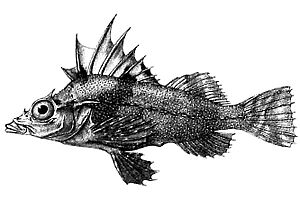Antarctic horsefish facts for kids
Quick facts for kids Antarctic horsefish |
|
|---|---|
 |
|
| Conservation status | |
| Scientific classification |
The Zanclorhynchus spinifer, also known as the Antarctic horsefish or spiny horsefish, is a type of ray-finned fish that lives in the ocean. It belongs to a group of fish called Congiopodidae, which are known as horsefishes or pigfishes.
You can find this fish in the Southern Ocean. It usually lives deep underwater, from about 5 to 400 meters (16 to 1,312 feet) below the surface. The Antarctic horsefish can grow up to 40 centimeters (16 inches) long. It's not a very important fish for big fishing companies.
Contents
About the Antarctic Horsefish
Scientists give every living thing a special name, like Zanclorhynchus spinifer. This helps them organize and understand all the different species on Earth.
Naming the Fish
The Antarctic horsefish was first officially described in 1880. A scientist named Albert Günther, who was born in Germany but worked in Britain, gave it its name. He found this fish near Kerguelen Islands.
Günther placed this new fish in its own special group, or genus, called Zanclorhynchus. For a long time, it was the only fish in this group. But in 2016, another type of horsefish, called Chereshnev's horsefish, was discovered and added to the same group.
What its Name Means
The second part of its scientific name, spinifer, is Latin. It means "bearing spines." This name was chosen because the fish has many spines on its head bones.
What it Looks Like
The Antarctic horsefish has a unique look. It has two dorsal fins on its back. The first one has 7 to 10 sharp spines. The second dorsal fin has 12 to 15 soft rays. There's a deep cut between these two parts of the dorsal fin.
Its anal fin (on its belly) has 10 or 11 soft rays but no spines. Inside its mouth, it has tiny teeth in rows.
This fish is very spiny! It has a spine above each nostril. There are also clear spines behind and under its eyes. A very long spine sticks out above its gill cover. The gill cover itself has three small ridges that end in spines. You can also find another spine on its body near its pectoral fins (side fins).
The upper part of its body and sides have scattered scales, but its lower parts are smooth. The fish's color can be brownish, purple, or a yellowish-brown, often with small black spots. It has a black stripe running from its second dorsal fin down to its anal fin. Another black stripe is on the front part of its caudal fin (tail fin).
There's a black spot at the base of the first two spines on its dorsal fin. A black bar also goes from the back of the first dorsal fin down to its lower body. Its fins are yellow, with black stripes in the middle of its tail, pectoral, and pelvic fins (bottom fins). The biggest Antarctic horsefish ever recorded was 40 centimeters (16 inches) long.
Where it Lives and What it Likes
The Antarctic horsefish lives in the Southern Ocean, especially in the parts near the Indian and Pacific Oceans. It has been found in places like Macquarie Island (Australia), and French Southern Territories like Crozet, Kerguelen, Heard, and McDonald Islands. It also lives near the South African Marion and Prince Edward Islands.
You can also find them on underwater mountains called seamounts, such as the Hercules Ridge. The Antarctic horsefish is a benthic species, which means it lives on the seabed. Fishing boats have caught them at depths ranging from 5 to 400 meters (16 to 1,312 feet).
How it Lives
The Antarctic horsefish spends most of its time on the ocean floor. It hunts for small animals that live on the seabed, especially tiny crustaceans called amphipods. It has also been found living among beds of kelp, which are large seaweeds.
When they are very young, after hatching, these fish swim freely in the open ocean. They have been found far offshore in waters as deep as 1,500 meters (4,921 feet).
Sometimes, the Antarctic horsefish becomes food for other animals. For example, Hooker’s sea lions (a type of sea lion) have been known to eat them near Macquarie Island.
Fishing for Horsefish
The Antarctic horsefish is quite common. It is often caught by accident by trawlers, which are fishing boats that drag large nets. When fish are caught by accident, it's called bycatch.
The meat of the Antarctic horsefish is not usually sold for people to eat. Instead, it is often turned into fish meal, which is used as animal feed.


